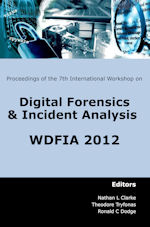In 2014, we launched our open-access repository which offers full text access to conference proceedings from many of our events including the INC and HAISA series. These papers are free to access and distribute (subject to citing the source).
» Openaccess proceedings » 7th International Workshop on Digital Forensics and Incident Analysis (WDFIA 2012)
 | 7th International Workshop on Digital Forensics and Incident Analysis (WDFIA 2012) |
Title: Finding Digital Forensic Evidence in Graphic Design Applications
Author(s): Enos Kudakwashe Mabuto, Hein Venter
Reference: pp12-26
Keywords: Digital evidence; Digital forensics; Digital forensic artifacts; Graphic design applications.
Abstract: Graphic design applications are often used for the editing and design of digital art. The same applications can be used for creating counterfeit documents like identity documents (IDs), driver’s licenses or passports among others. However the use of any graphic design application leaves behind traces of digital information which can be used during a digital forensic investigation. Current digital forensic tools examine a system to find digital evidence but they do not examine a system specifically for the creating of counterfeit documents. This paper reviews the digital forensics analysis process involved in the creation of counterfeit documents by determining and corroborating the events that previously occurred. Firstly the analysis is achieved by associating the digital forensic information gathered to the possible actions taken, precisely, the scanning, editing, saving and printing of counterfeit documents. The digital forensic information is gathered by analyzing the files generated by the particular graphic design application used for document creating. Secondly an analysis is conducted on user generated files, the actual files that can be used as potential evidence to establish file structural contents and the relationship with the associated actions. This involves analyzing the user generated files associated with these applications and determining their signatures and related metadata. The authors also elaborate on tools and techniques that can be used to extract digital evidence related to certain graphic design applications. The acquired digital forensic information is corroborated to the creation of counterfeit documents and interpreted accordingly.
Download count: 2192
How to get this paper:


PDF copy of this paper is free to download. You may distribute this copy providing you cite this page as the source.
